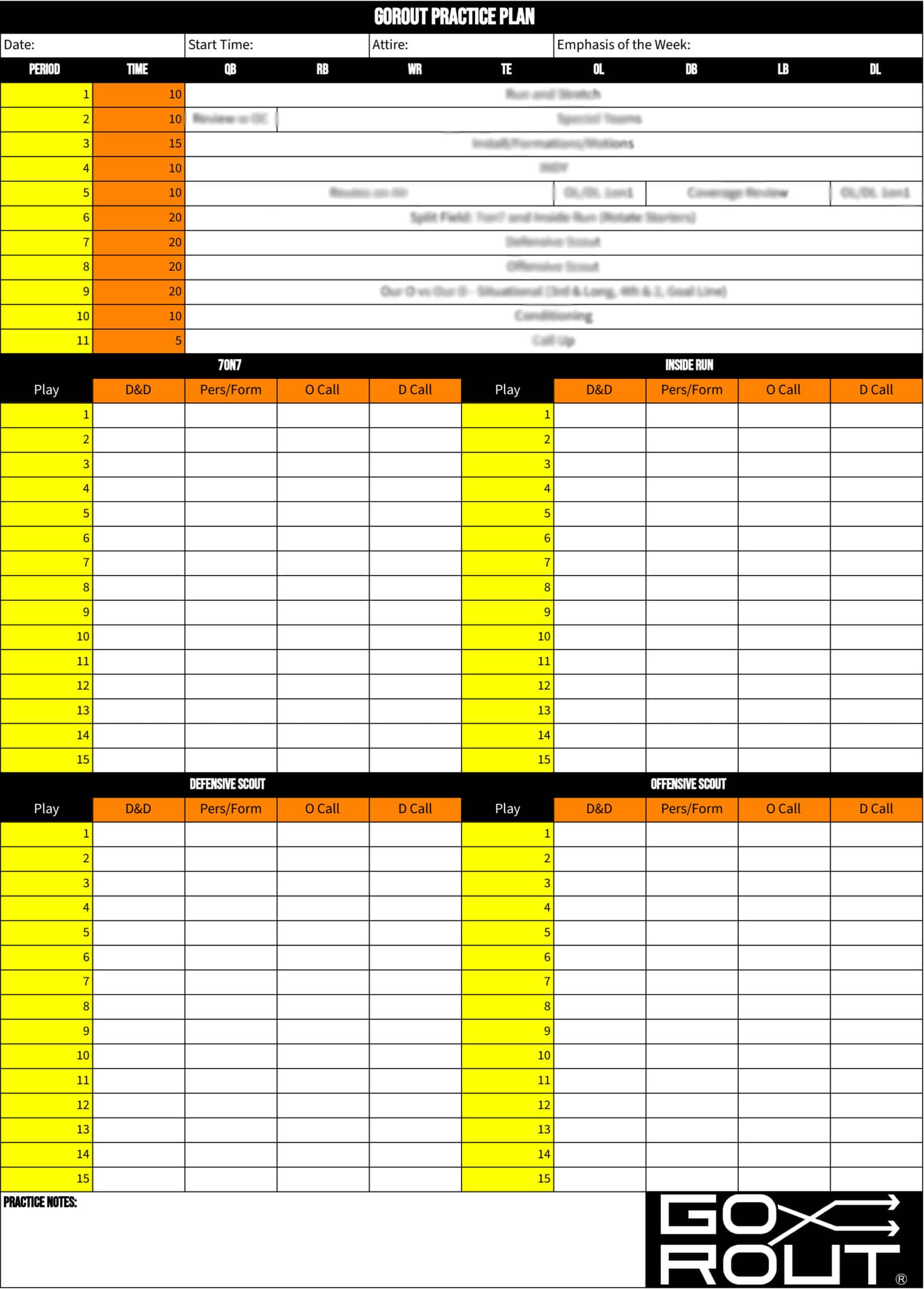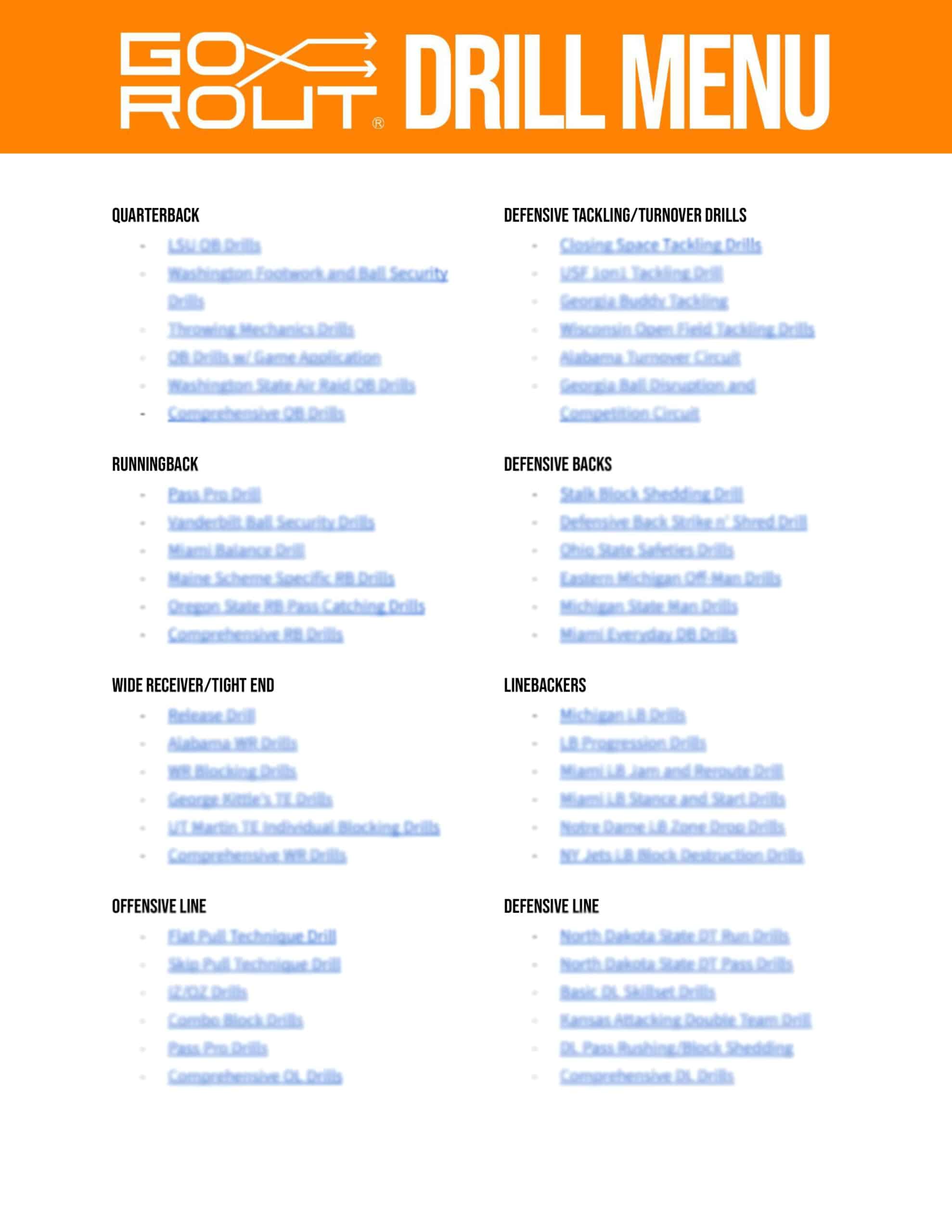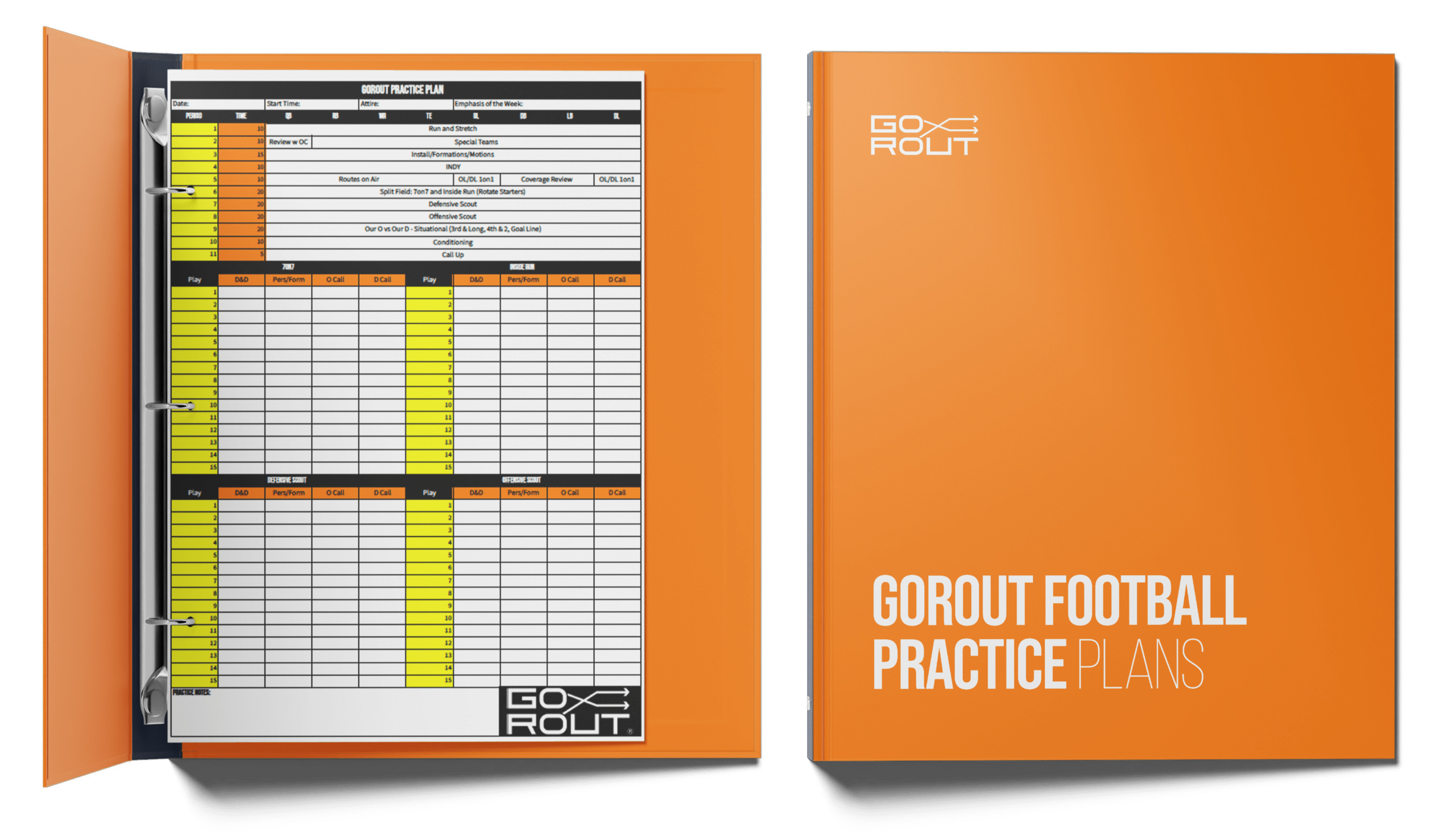Football Practice Planning
Creating an organized football practice plan helps your entire coaching staff get the most out of your allotted practice time. No matter the skill level, structuring a strict time schedule ensures players remain focused, build important skills and techniques, cover all three phases of the game, and prepare for each game throughout the season.
5 Tips for Planning Football Practice
Here are five tips for planning effective, efficient football practices at any level:
- It’s important to balance the three phases of football (offense, defense, and special teams) throughout practice. If you spend too much time on one phase of the game, the other two will suffer. Over the duration of a season – and within each week – you should cover a mix of drills, plays, formations, schemes, and situations for each phase.
- Dividing practice into structured, shorter training blocks helps your team stay focused and ensures you cover every part of the game equally. By dedicating shorter periods of time to focus on specific segments, players stay engaged and remain more productive in less time. It also forces coaches to be extremely organized and purposeful.
- Setting a clear timeline helps players and coaches focus on the task at hand. With a concise, specific football practice script, there is no room to get distracted or you’ll fall short of your goals.
- Filming practice enables coaches to make adjustments. No matter the size of your staff, it’s difficult to see everything that happens during practice. By using any video camera (your phone, a tablet, or an actual video camera), coaches can record practice and review after. This helps you identify mistakes and provide feedback to players.
- Reviewing and adjusting practice plans based on previous performance and player development ensures your team is always progressing. It doesn’t make sense to keep practicing the same way if you aren’t getting results. Analyzing the performance of your team and individual players helps inform what areas you need to work on and how you should adjust your practice structure.
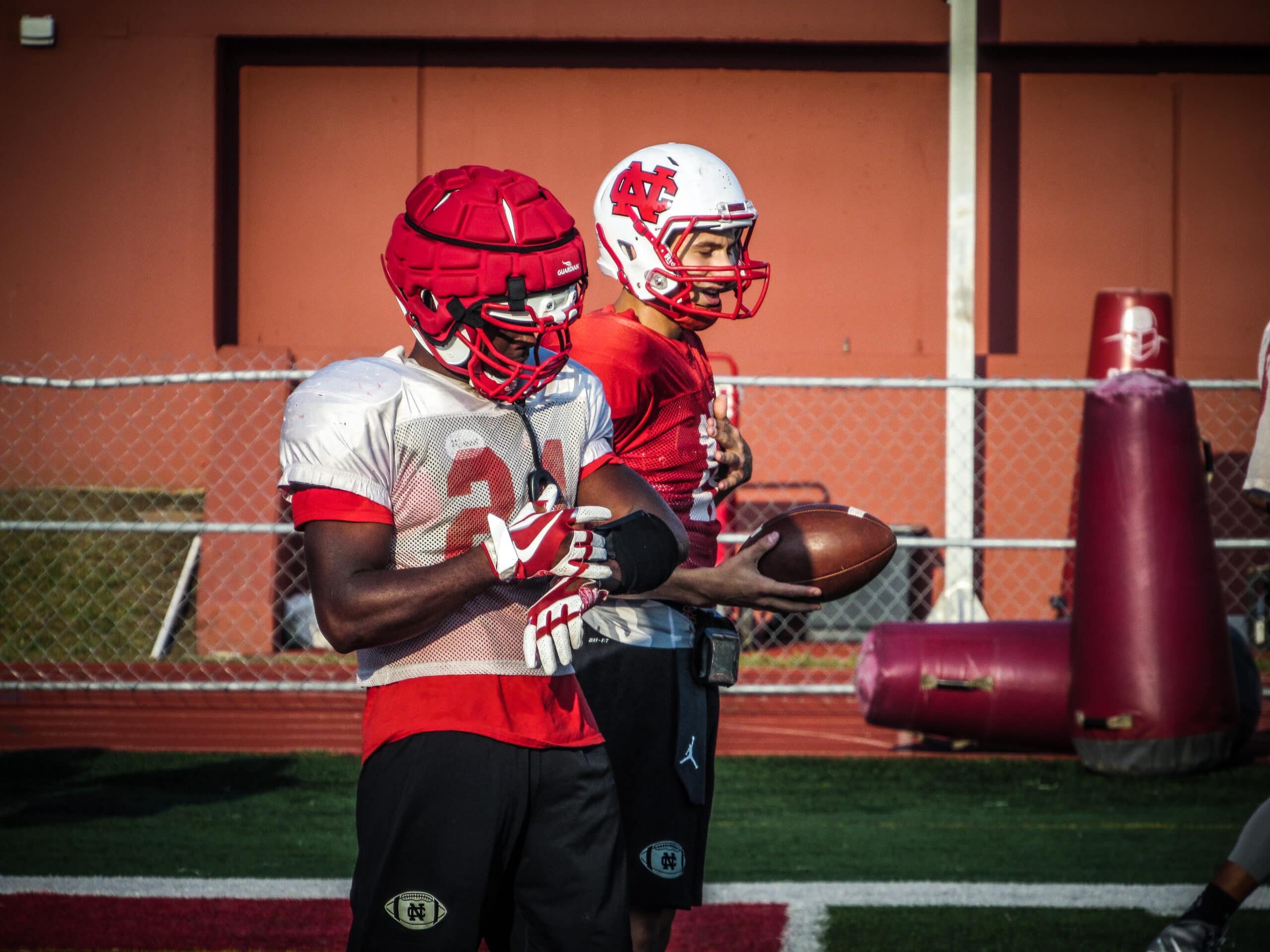
Planning Practice For Youth Football
Coaching youth football requires a different approach from more advanced levels. At the lowest levels, practice is about introducing kids to the game, its rules, basic fundamentals, and safety considerations.
When working with young athletes new to the sport, it’s important to give them exposure to all aspects. Between offense, defense, and special teams, there’s a lot to cover. Depending on the level you’re coaching, you may need to spend more time introducing the most basic concepts physically and mentally.
Teaching Fundamental Skills
Fundamentals are the foundational skills and abilities required to actively participate in a football game. No matter the age, a basic understanding of the fundamentals should be one of the first periods of practice.
Introduce and work on skills like:
- Blocking
- Tackling
- Catching
- Receiving handoffs
- Running with the ball, and
- Throwing
Make sure to show your players the proper form for each skill and provide step-by-step instructions with examples. To be a good blocker, players need to learn the proper stance and footwork. Tackling form and technique is essential to player safety, especially at developmental ages.
Educating Players On The Game
Young players often have varying levels of knowledge on the rules of the game and penalties, and how to play. As a youth coach, you need to educate players. While some may have previous experience to a degree, make sure everyone has a sound understanding.
Introducing Offensive and Defensive Strategies
When your players show progress in their fundamentals, start introducing offensive and defensive strategies. Teaching basic formations and plays puts the knowledge and foundational skills into practice.
If you’re coaching older age groups in youth leagues, you can introduce and explain more complex schemes and concepts. No matter the age level, working in smaller groups helps players gain an in-depth understanding of both sides of the ball.
Developing Cognitive Skills
Football is a mental game and it’s never too early to focus on cognitive skills. This ranges from anticipating where players will be on the field to avoid injuries to reading defensive formations and making smart decisions.
While players develop cognitive skills through experience, instruction and education are vital. Talk through the importance of spatial awareness on the field, highlighting the risk of injury from not paying attention to your surroundings. When working with young running backs, discuss how they need to read defenders and react quickly.
Keep It Enjoyable
Part of youth sports is giving kids a memorable, enjoyable experience. When they’re first introduced to the sport, it’s important that players have fun and associate football with positivity.
As players learn new skills, be sure to celebrate little wins and accomplishments to keep them motivated. Providing constructive criticism and feedback is necessary to help kids grow and improve, but it should be framed in a reassuring manner that emboldens them to keep working.
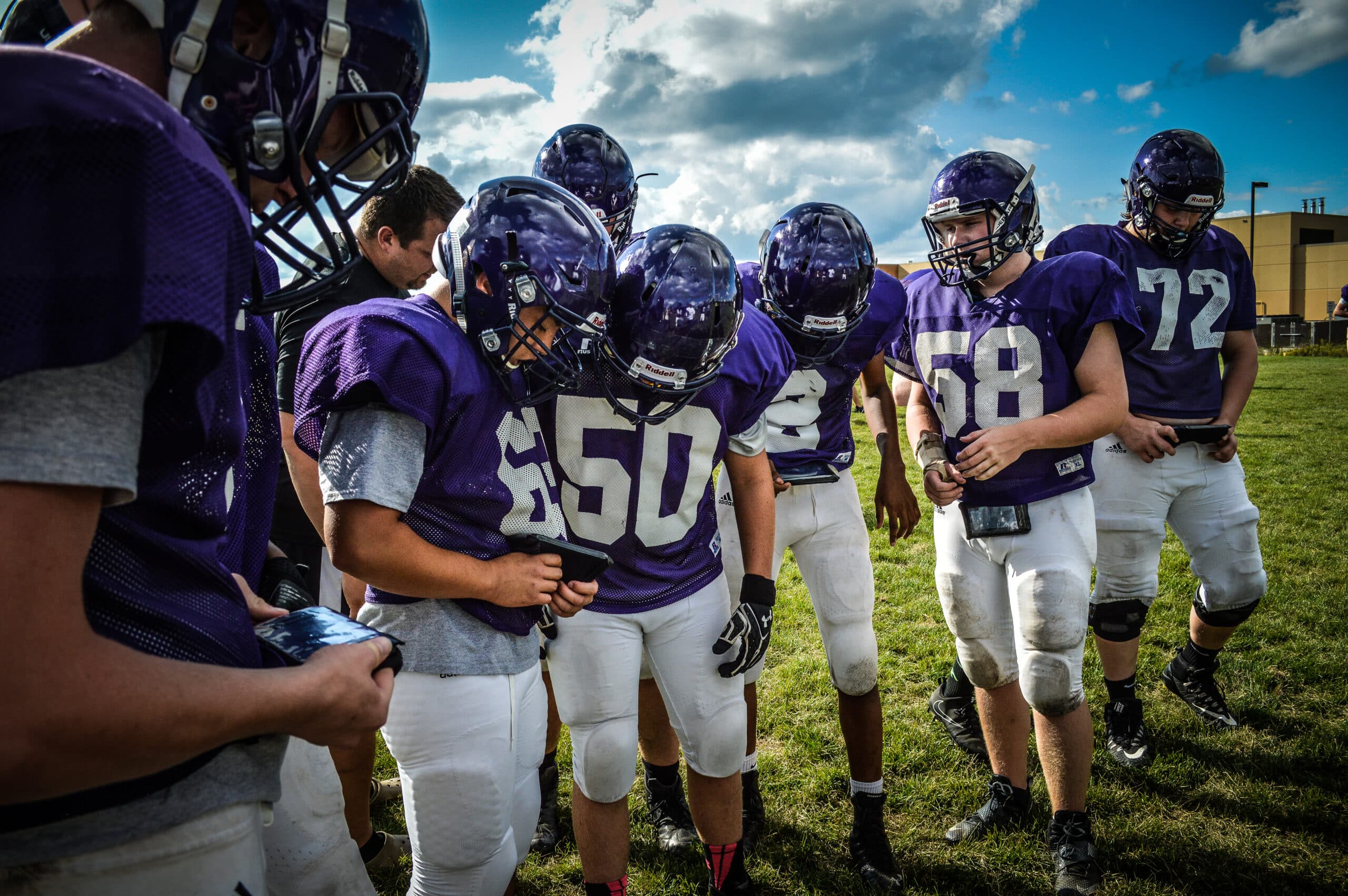
How To Plan Efficient & Effective Football Practices
When you hit the field every day, you want to get the most out of your allotted practice time. Purposeful practice is the difference between winning programs and the rest of the field.
To plan efficient and effective practices for your football team, consider focusing on these key components:
- Organization
- Culture
- Short periods
- Film
- Player-focused practice
- Water breaks and transitions
- Tempo
Organization
An organized, methodical practice ensures you cover the most material in your given time. When you’re planning your practice, account for time down to the minute. As you’re developing your schedule, consider and work with all other coaches on your staff.
- Collaboration and delegation are essential. Have position coaches control and prepare their own practice segments to enhance efficiency, allowing you to focus on the big picture. Delegation is one of the best ways to coach football.
- Over plan and anticipate hiccups along the way. If you’re flying through drills successfully, you may be able to cover more than you originally thought. When players struggle with certain aspects of practice you only allot a brief section for, it forces you to adapt your plan.
Organization keeps you prepared. Everything from drills and practice equipment to the time schedule and groups, it should all be determined prior to stepping on the field.
Culture
You and your coaching staff set the tone. Develop a practice culture and routine as a staff that reflects your coaching philosophy and goals. Before the season begins, meet with coaches to align on goals and how you want to coach your players.
Culture must be coached. Players don’t inherently show up with an understanding of how you like to practice. If you want your team to have intensity and purpose in every step, you need to tell them. Many players will come ready to go, but it’s up to you to shape their habits and mentality to define your team’s practice culture.
Short Periods
Splitting your practice up into short, timed periods keeps your players engaged and helps get more done in less time. By timing out short, defined time blocks, players will be sharp and focused. Keeping drills short and sharp also improves your players retention and skill execution.
- For example, setting brief ten-minute indy periods gives players one-on-one or small group time with their position coach. In that time, they may be able to complete three or four drills with intensity and purpose. That’s better than spending thirty minutes on the same drill, with players drifting off and losing focus.
This goes hand-in-hand with organization. Timing drills into blocks is crucial for maximizing efficiency and ensuring accountability.
Film
Film can be used in multiple ways for football practice. The most obvious purpose is to review film from previous games to self-scout and prepare for opponents. Watching film of the other team allows you to incorporate their strategy and tendencies into practice. Scouting and examining your team’s performance from previous games helps to adjust future practice plans.
On the practice field, you only have a certain number of coaches. It’s impossible to see everything. You can set up cameras or hire/recruit camera people to come film your practices. That way, you can analyze practice performance after each session to see what worked and where you can improve.
Player-Focused Practice
While you and your coaches set the practice culture, and your opponents determine the flow of your week, your players should always be at the forefront of your practice plans. Your practice should be planned based on player developmental progress and team health for optimal performance.
Especially with position coaches during indy periods, the drills and focus should be tailored to the players on your team. If the team is struggling with a certain concept as a whole, take time to address that issue head on instead of barreling ahead in your predetermined plans for the week.
As previously mentioned, health plays a major role as well. If your team got physically beat up in a tough matchup the previous week, it might help to turn down the physicality and allow their bodies to heal. Even if it goes against your culture or plans, practice should adhere to the health of your team.
Water Breaks and Transitions
Keeping your players hydrated is important, but you need to find the best way to keep water breaks and transitions efficient.
- Some coaches opt to have water bottles or stations readily available for players to quickly grab a drink while they aren’t actively participating in a drill. This cuts out any official “water breaks” that extend to unnecessary chit-chat or derail your practice plan, even by a few minutes.
- Certain leagues or areas have rules and regulations that require players to receive a water break. In those cases, make sure breaks are as efficient as possible. Don’t allow players to dilly dally and lose their focus or intensity.
The same goes for transitions in between drills and periods. Quick transitions between segments increases efficiency and maximizes time. It also keeps players on their toes and forces them to be purposeful in every step they take.
Tempo
Football practice is about reps, and to get the most reps in you need to have up-tempo sessions. Practice faster than the game and don’t aim for perfection. Correct players when they make mistakes, but don’t hold up practice trying to hit a drill 100% correctly.
Incorporating practice equipment like GoRout maximizes your practice time, helping to increase reps and reduce wasted time.
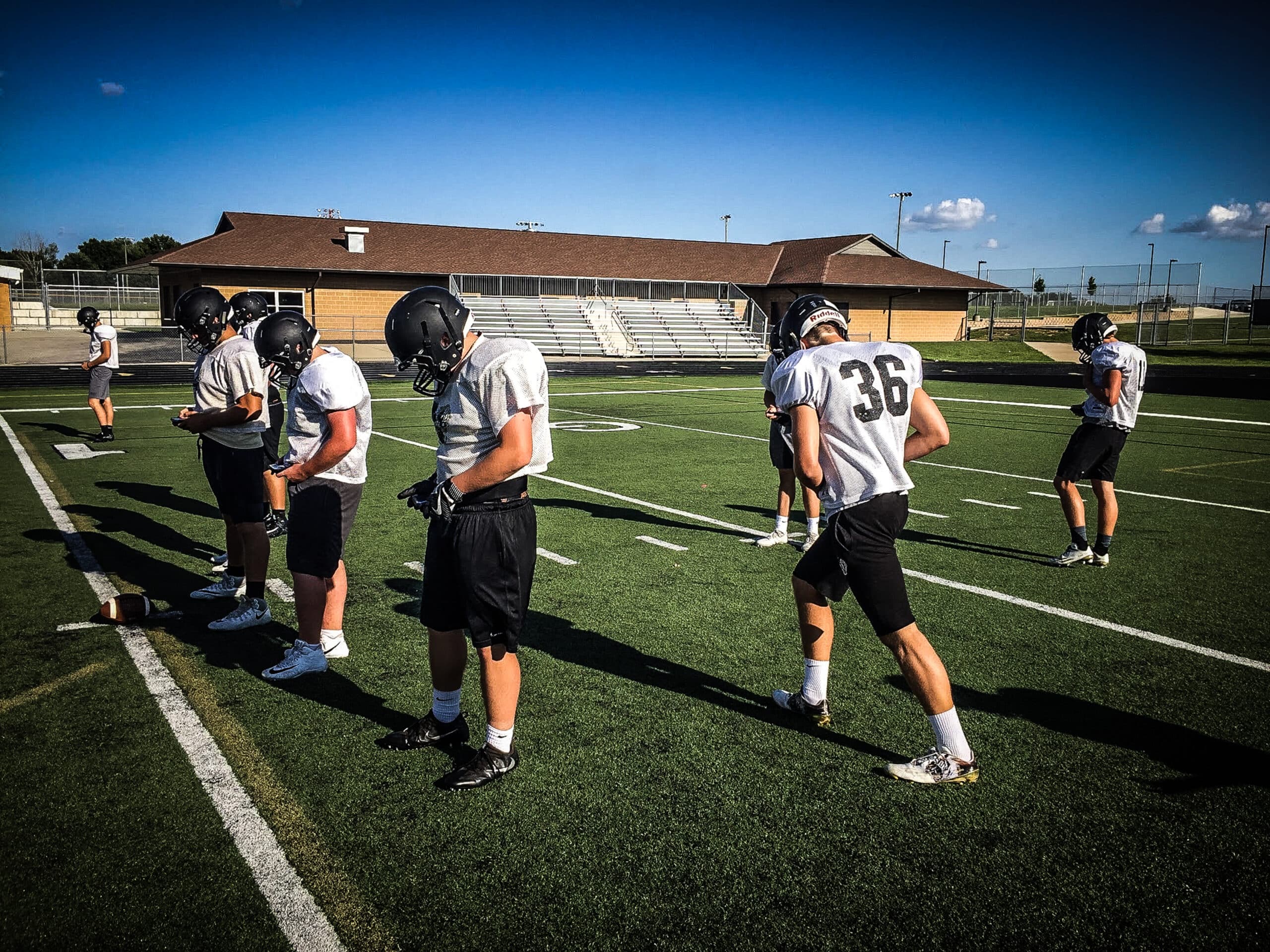
Seasonal Football Practice Planning
The goal of practices, and your planning strategy, changes throughout the season. What you focus on in the pre-season greatly differs from the week of a winner-take-all playoff matchup.
Football practice planning can be split into four phases of the season:
- Pre-Season
- In-Season
- Playoffs
- Offseason
Pre-Season
The pre-season is all about establishing the foundation for your year ahead. In the weeks leading up to the first game, you should focus on building your team.
No matter the level you’re coaching, pre-season is the time to refine the fundamentals. Position-by-position, these practices grind out the basics to assess players' form.
Coaching staff reiterate and instruct on technique during the pre-season, even in advanced leagues. Position coaches go through core drills and fundamentals to get a feel for their group and help players establish a sound foundation to build upon.
The pre-season is grueling physically and mentally. In these weeks, you introduce your team’s strategy by installing offensive schemes and defensive schemes. Players are instructed and coached up on your team’s playbook, and it’s their job to learn and memorize plays and their roles within.
Conditioning drills prepare your team for a long, physically demanding season. Teams that emphasize conditioning in pre-season practice sessions are more likely to outperform their opponents in tough late-game situations
Regular Season
Once the season begins, your focus shifts to opposing teams. Studying film and game planning for your opponent takes the majority of practice time. Each week you prepare for the upcoming game by watching your opponent’s film and preparing for them on the field.
Your first team units – both offense and defense – run against scout teams who give simulated looks of formations, schemes, behaviors, and tendencies your opponent will likely show on game day. You’ll also run your first team offense versus your first team defense in various situational simulations.
Though the majority of your focus centers on the opponent, still take time to work on fundamentals and core drills. As you move further into the season, assess your team’s performance each week along with game planning for opponents. That way, you address your weaknesses and correct any issues from the previous week while simultaneously preparing your team for the upcoming game.
Playoffs (Postseason)
If you’re fortunate enough to make the playoffs, or any other postseason tournament, your approach changes slightly from the regular season. Every week in the postseason is likely a “win or go home” situation, so the stakes are higher.
It’s important not to stray too far away from what brought you success during the regular season. Fine tuning fundamentals and core drills helps maintain a laser-sharp focus on each position group’s foundation. Fundamentally sound football teams have the best odds of success in high-stakes postseason competition.
With a full season of film to analyze, game planning for playoff opponents is a more robust, intense process. Try not to stray too far from the normal weekly routine of the regular season. Take more time during scout to dive into your game plan and address everything you’ve seen in film. There’s no second chances, so your team needs to be locked in all week.
Offseason
Every league has different restrictions for official offseason team practices. Players should develop offseason football workout plans tailored to their individual weaknesses and goals. These are personalized workout programs that they’ll complete on their own time. Some players like to meet up and work together on certain skillsets, like quarterbacks and wide receivers.
In official team settings, your limited time will focus on building strength for the season ahead and addressing any issues from the previous season. It’s also a time for players to rehabilitate and recover from the physical demands of last season while preparing their body for the next year.
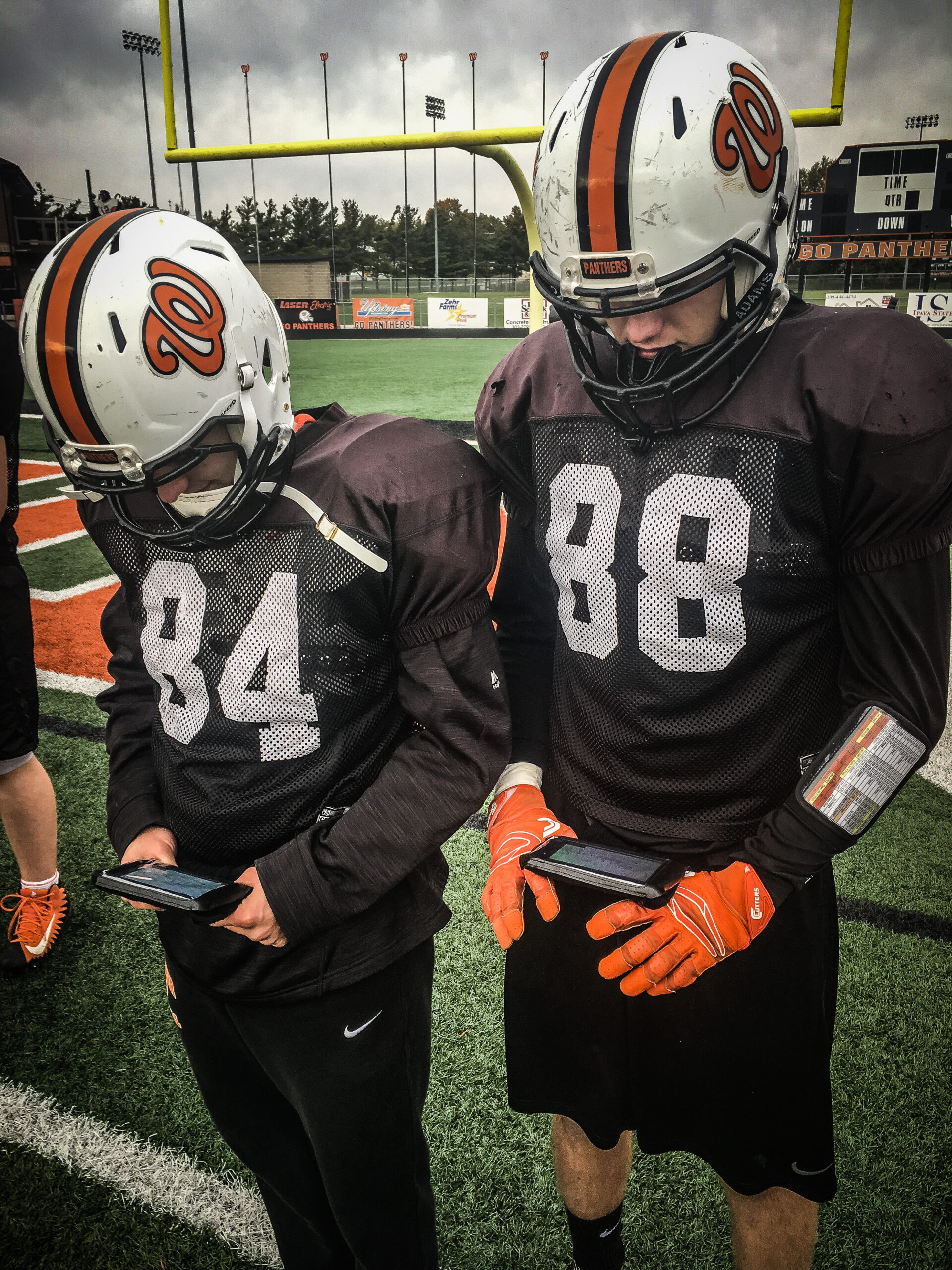
Planning Football Practice In Periods
One of the most important takeaways from this resource is to break your practice into timed periods for maximum results. Each “section” of your practice builds upon the other, focusing on smaller details that make up the bigger picture.
There are three main “sections” or periods of football practice:
- Individual (Indy)
- Group
- Team
Individual (Indy)
Individual practice periods are referred to as “indy” time. This is the portion of practice when players work with their dedicated position coach on drills specific to their role. Indy periods are essential for coaching and honing fundamentals.
During indy periods, coaches run core drills focusing on form and individual techniques. It’s also a time to work on specific mental components of offensive and defensive strategies. For example, the offensive line can work on fundamentals and form through sled work and offensive strategy by reviewing blocking rules.
Indy periods are essential to growing as a team, because it gives players intimate, one-on-one time with position coaches. That individual work makes group and team sessions more effective.
Group
Group periods bring multiple positions together in small groups to work on specific drills and situations. It builds off of indy time, taking the components covered and combining them with other position groups who work closely together.
For example, you can bring all offensive skill players (quarterbacks, running backs, wide receivers, and tight ends) together to run routes on air.
This incorporates work from each respective indy period into a more situational setting with:
- Quarterbacks practicing footwork and throwing fundamentals
- Running backs practicing their receiving skills and pass protection
- Wide receivers and tight ends working on running through the football route tree
There are many other examples of positions combining for group periods. The main purpose is to work on communication and timing between multiple position groups that rely on each other on game day.
Team
Full team periods bring everyone together for 11 vs. 11 practice. This is the closest teams get to real game conditions without playing a game. It simulates live situations and prepares players for various scenarios. Team periods teach players how to adjust on the fly and deal with adversity.
Some key team periods include:
- Offensive scout and defensive scout
- Down and distance situations
- Goal line
- Red zone
- Other situational practice
- Special teams
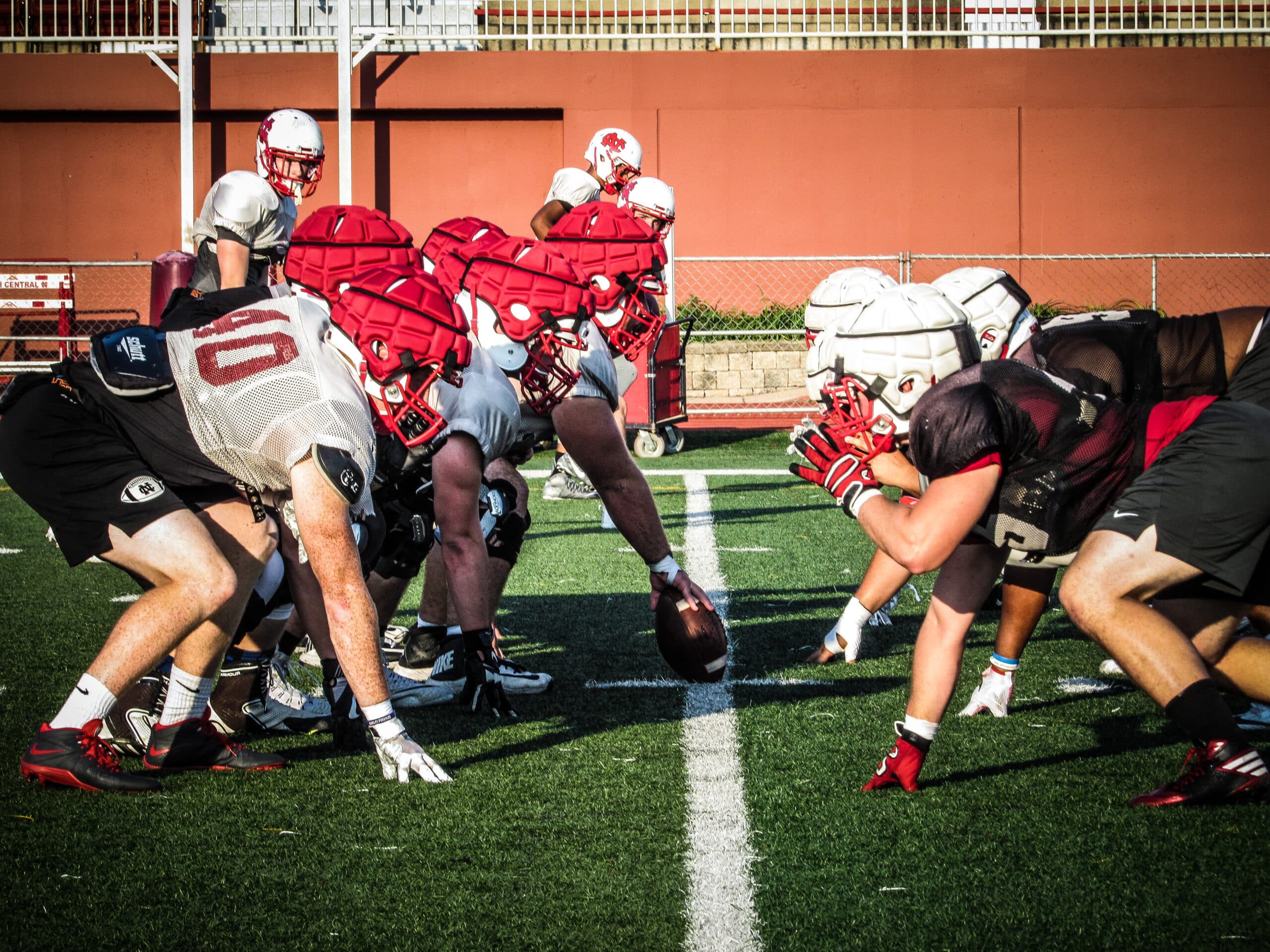
Weekly In-Season Football Practice Plan: Daily Breakdown
Within the regular season, your strategy varies by opponent. Regardless of who you’re playing, it’s important to establish a semi-consistent weekly routine to help players get the most out of their week and adequately prepare for the upcoming game.
Your weekly schedule varies depending on a number of factors including the level of competition and amount of time you have with your team. An NFL team’s weekly schedule is completely different from a youth football team.
Here’s an example of a weekly in-season football practice plan for a high-school team that plays on Friday nights.
| Day of the Week | Practice Focus |
| Sunday |
|
| Monday |
|
| Tuesday |
|
| Wednesday |
|
| Thursday |
|
| Friday |
|
| Saturday |
|
Sunday
Sunday is the beginning of your week as a coach. Success starts with your coaching staff. Each week, it’s important to meet as a staff to align on the week’s goals and come up with a plan of action to prepare. Use Sunday for coaches to meet up and discuss strategy. Players get the day off and don’t have to report.
Coordinators should have scout film ready and discuss their plans with position coaches. Together they review the film and identify areas of focus. Position coaches assist coordinators in analyzing the film. This is where they come up with their core game plan.
From there, the coaching staff develops the week’s practice schedule and a scouting report.
Monday
Monday is a big film day. Players first report to meeting rooms – either as a full unit, offense/defense only, smaller groups, or by position – for scout film sessions. They break down the tape with coaches and begin discussing the plan of attack. This usually lasts around an hour.
Then, players get dressed and out on the field for a full practice. Monday’s practice incorporates indy, group, and team periods with a focus on fundamentals and conditioning. In high school football, this is often the day when Freshman and JV teams play their games.
Tuesday
Tuesday practice is often physical. Players had enough time to fully recover from the previous game and a physical practice gets your team in a competitive mental state.
This practice requires a ton of focus and mental strength. Coordinators install the offensive and defensive game plan for the week’s opponent, so players need to be locked in.
Wednesday
Wednesday is another full practice with a mix of indy, group, and team work. Continue to address the game plan against scout teams.
Thursday
Thursday is the day before game day. Keep practice light with a walk through. Players only need shorts and helmets. The primary focus is mental preparation for the game. Coming out of Thursday’s practice, you should feel ready and confident in your game plan and team.
Friday
Friday is game day! This is when all of your prep and game planning comes to fruition.
Saturday
Saturday morning is a quick turnaround for coaches to review Friday night’s game. Whether as a full team or in smaller groups, Saturday is a self scout film session. Players and coaches review the tape and assess their performance.
Coming out of Saturday’s session, players should know what they need to work on and improve. Coaches should know what they need to emphasize in the upcoming week of practice and be ready to scout the next week’s opponent at Sunday’s coaches film session.
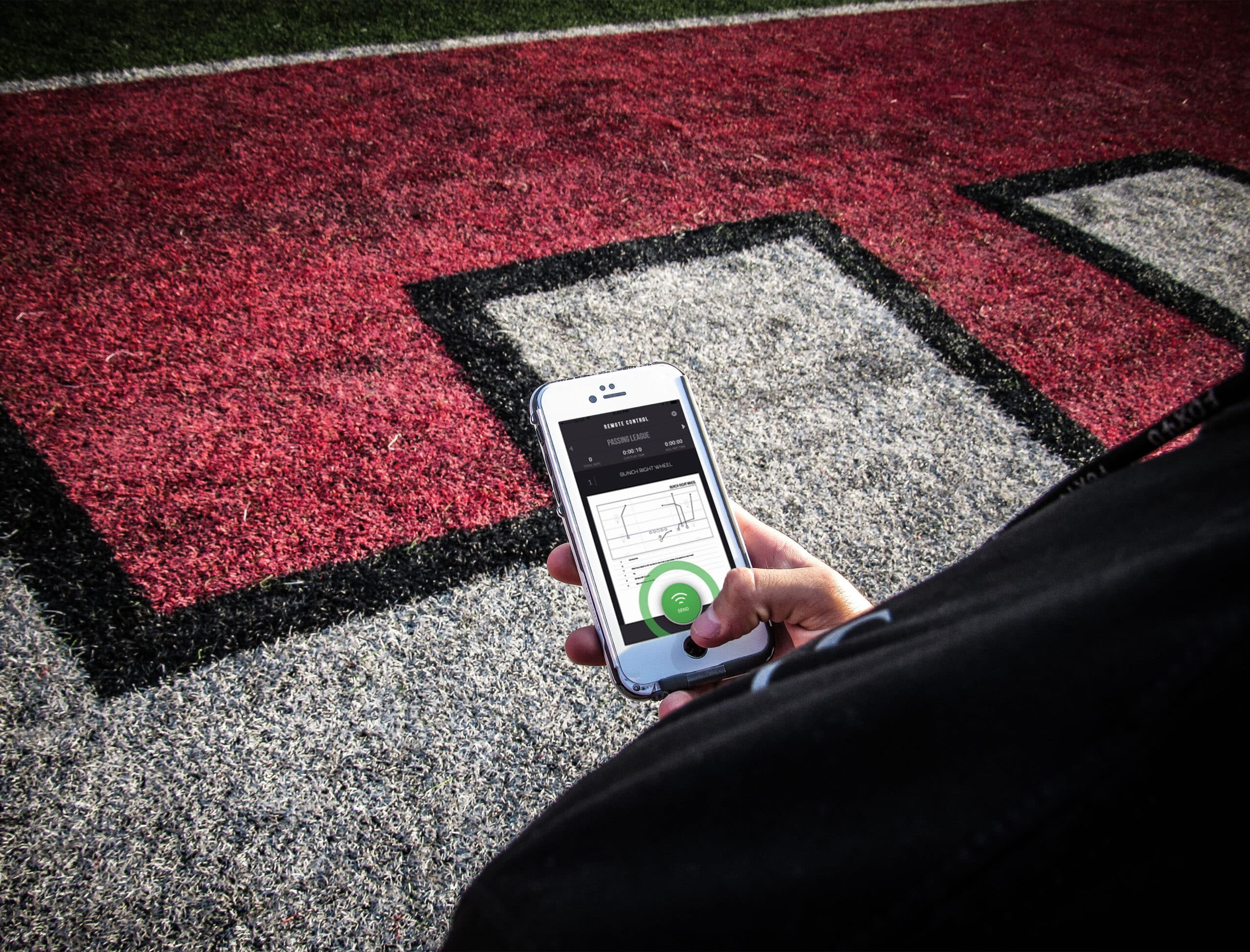
Football Practice Plan Examples
Now that you understand how to plan effective practices and the work that goes into them, we’ll provide an example of a football practice plan. We’ll provide one example for advanced teams and one for youth coaches.
Advanced Football Practice Plan (High School or College) Template
The following is an example practice plan template for an advanced football team, likely middle school, high school, college level, or above.
| Period | Segment Name | Time | Explanation |
| 1 | Run and Stretch | 10 minutes | Get the legs loose and stretch to prevent injuries during practice |
| 2 | Special Teams | 10 minutes | Work on special teams early to get the bodies moving |
| 3 | Install/Formations/Motions | 15 minutes | Install new plays, formations, motions, and concepts early in practice while players are mentally and physically fresh |
| 4 | Indy | 10 minutes | Divide team by position into as many groups as possible. In given time, rotate players through position-specific drills covering fundamentals and technique. Include instruction on responsibilities and roles within the larger team. |
| 5 | Group Work | 10 minutes | Combine position groups that work together. Use this time to work on communication and timing, building off of indy periods. |
| 6 | Split Field | 20 minutes | Split the field into two groups, focusing on different concepts. |
| 7 | Defensive Scout | 20 minutes | Run your first-team defense against scout offense to prepare for the opponent’s offense (strategy and tendencies), implementing and simulating your defensive game plan. |
| 8 | Offensive Scout | 20 minutes | Run your first-team offense against scout defense to prepare for the opponent’s defense (strategy and tendencies), implementing and simulating your offensive game plan. |
| 9 | Situational Team Work | 20 minutes | Have your offense and defense line up against each other to run through specific situations like 3rd and long, 4th and short, goal line, and other scenarios. |
| 10 | Conditioning | 10 minutes | Close out practice with various conditioning drills to build cardio strength and endurance, specifically when already exhausted. Depending on the day of the week, the intensity of conditioning will vary. |
| 11 | Cool Down | 5 minutes | Come together as a team for a cool down of light stretching and movement to prevent injury and soreness. |
Youth Football Practice Plan Template
The following is an example practice plan for a youth football team that’s focused on introducing players to the game and fostering a positive environment for growth and development.
| Period | Segment Name | Time | Explanation |
| 1 | Run and Stretch | 10 minutes | Get the legs loose and stretch to get the blood flowing and prevent injuries during practice |
| 2 | Defensive Instruction | 20 minutes | Teach various defensive positions, formations, and plays. |
| 3 | Tackling Drills | 20 minutes | Run through a variety of tackling drills. In this time, it’s important to focus on form and technique to ensure players are tackling properly to avoid injury. In flag leagues, this can be substituted for flag-pulling practice and general defensive drills. |
| 4 | Offensive Instruction | 20 minutes | Teach various positions, formations, and plays. |
| 5 | Run Offensive Plays | 20 minutes | Take time to practice running some of the offensive plays that you covered in the instructional period. You can also use this time to run position-specific offensive drills. |
| 6 | Conditioning | 10 minutes | Close out practice with various conditioning drills to build cardio strength and endurance, specifically when already exhausted. You can turn conditioning into games to keep it fun for younger kids. |
| 7 | Cool Down | 5 minutes | Come together as a team for a cool down of light stretching and movement to prevent injury and soreness. |
Using Technology for Enhanced Practice
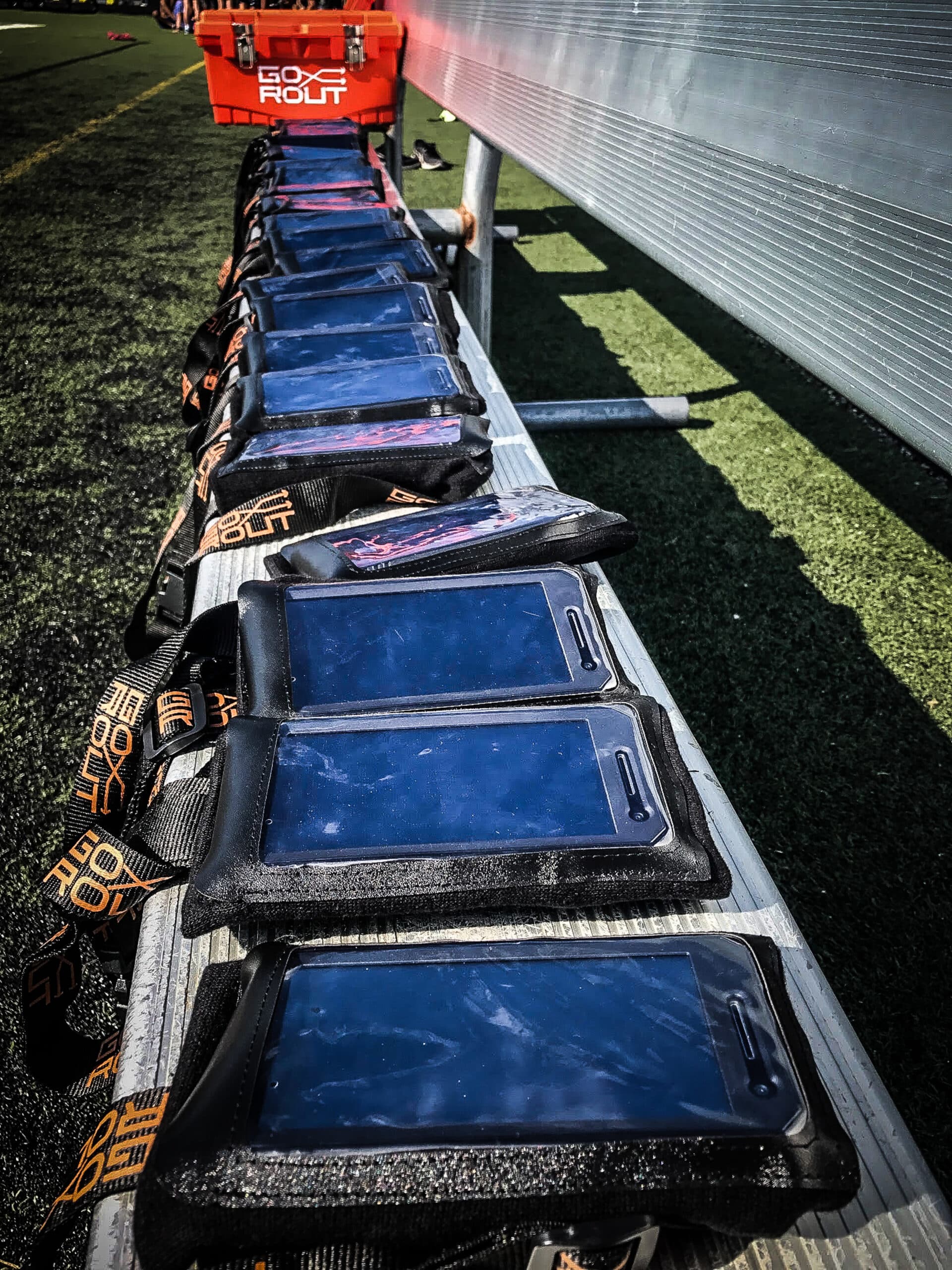
Football coaches know that time is a valuable commodity during practice sessions. Fortunately, the GoRout football play-calling system is a solution that streamlines communication between coaches and players, saves time and makes practices as efficient as possible.
GoRout’s web and mobile app, combined with wearable devices, allows coaches and players to instantly share and access play calls, increase practice reps, and enhance overall performance.
GoRout has become the go-to solution for football coaches across the country. It has transformed practice routines and taken weekly preparation to unprecedented levels of simplicity.
GoRout makes it easier for teams to prepare for game day and stay one step ahead of the competition.
Get a quote now.
Uploading and implementing practice scripts

Simplify practice scripting and organization by seamlessly integrating with popular play drawing tools. Our user-friendly web scripting app is compatible with any card drawing software.
It offers features for adding, editing, copying and reordering scripts or cards. Coaches can easily move plays between periods, saving time and improving their preparation for practices and games.
On-field practice mobile app
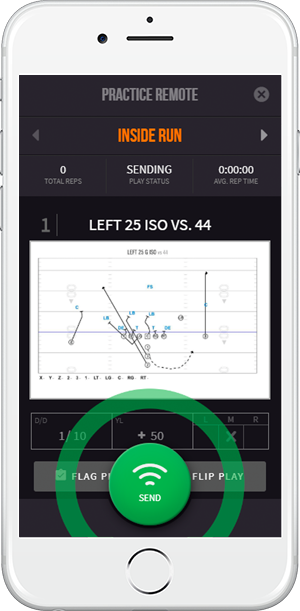
The on-field football practice app uses GoRout STEEL™ to streamline practice sessions. It helps you manage football practice’s beginning and ending, organize practice scripts, and share plays via a custom on-field remote.
GoRout enables quick and seamless communication with each player, providing features like on-field formation flipping, one-tap play flagging for instant review, and the ability to live-edit cards directly on the field.
Rugged player devices
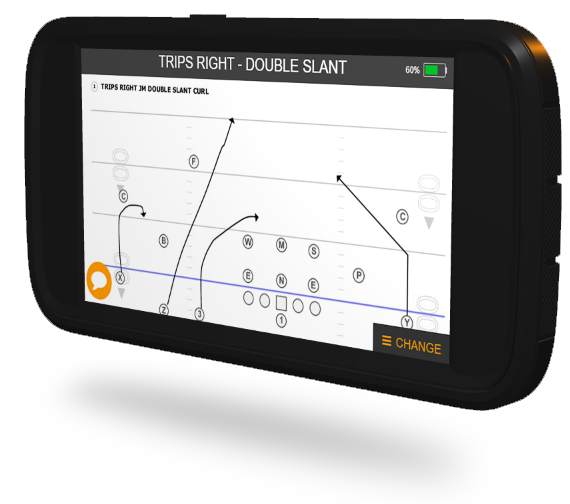
GoRout player devices can endure the demands of long and demanding football practices. They eliminate the need for setup or WiFi connectivity, offering a hassle-free experience right out of the box.
Coaches can efficiently distribute play calls to players by selecting practice groups.
These devices also provide access to play drawings and position-specific messaging, helping teams stay focused and well-prepared throughout their practice sessions.
Key Benefits of GoRout Football Practice Solution
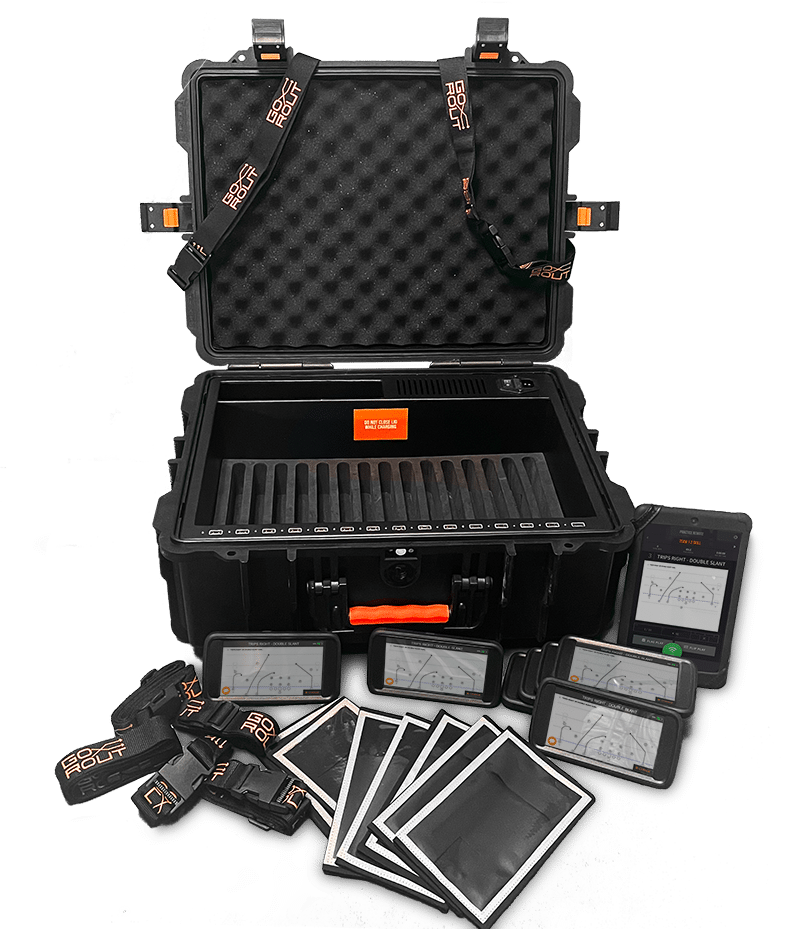
GoRout’s football practice solution is one of the best sports communication systems available today, and it has many benefits.
- Developed by coaches for coaches: Experienced coaches developed the system, offering an advanced solution based on firsthand coaching experience.
- Seamless integration: Coaches and players benefit from the effortless integration with play drawing tools, hand-drawn cards and more.
- Increased efficiency: GoRout enhances practice efficiency by increasing the team’s average reps by 2.5. It frees up valuable time for additional coaching guidance and provides players with more opportunities for improvement.
- Durability: GoRout delivers reliable performance in any condition. The system thrives in diverse weather conditions, regardless of extreme temperatures, humidity, or precipitation, and guarantees reliability during crucial moments on the field.
- Warranty: Backed by a comprehensive 100% full-coverage warranty, GoRout gives users confidence in the reliability, security, and durability of the system.
Experience GoRout football practice to see how we can help you lead your team to a win on game day.
Testimonials from Coaches Using GoRout
Experienced football coaches use the GoRout system to enhance their practices. Here are some testimonials from satisfied users.
Vestal High School
“GoRout has immensely increased the number of reps on our scout teams (inside run, 7-on-7, and full team). Its ability to upload plays from Hudl has streamlined our process, reducing the workload year after year and eliminating the need to store countless play cards in the coach’s office. The ability to categorize segments of practice, send plays, coaches ability to flag and flip plays has reduced huddle time, allowing for more reps in practice which leads to less dead time in practice. GoRout devices have become an integral part of our daily practices thanks to their ease of use.” - Coach Bo Donlin, 2025
Ottawa University
“I definitely think GoRout is worth it for any coach out there. It’s not just a Division-1 tool, it’s not just a high school tool, it’s a tool for all of football. I think coaches are going to get left behind if they’re not using this technology in practice. We are saving time, seeing more reps, and our coaches are able to do more coaching.” - Coach Nick Davis, 2024
Northern Arizona University
“GoRout has been a game-changer for our football program over the last two years. It has drastically improved our practice efficiency in all three phases of the game. We have been able to get almost double the amount of practice reps since converting to their system over using the traditional handheld card system. Due to GoRout, we have eliminated a lot of wasted time in practice and focused much more on the development of our players and their game readiness each week. I highly recommend their system to any program looking to maximize their practice time and to improve overall performance.” - Coach Brian Wright, 2025
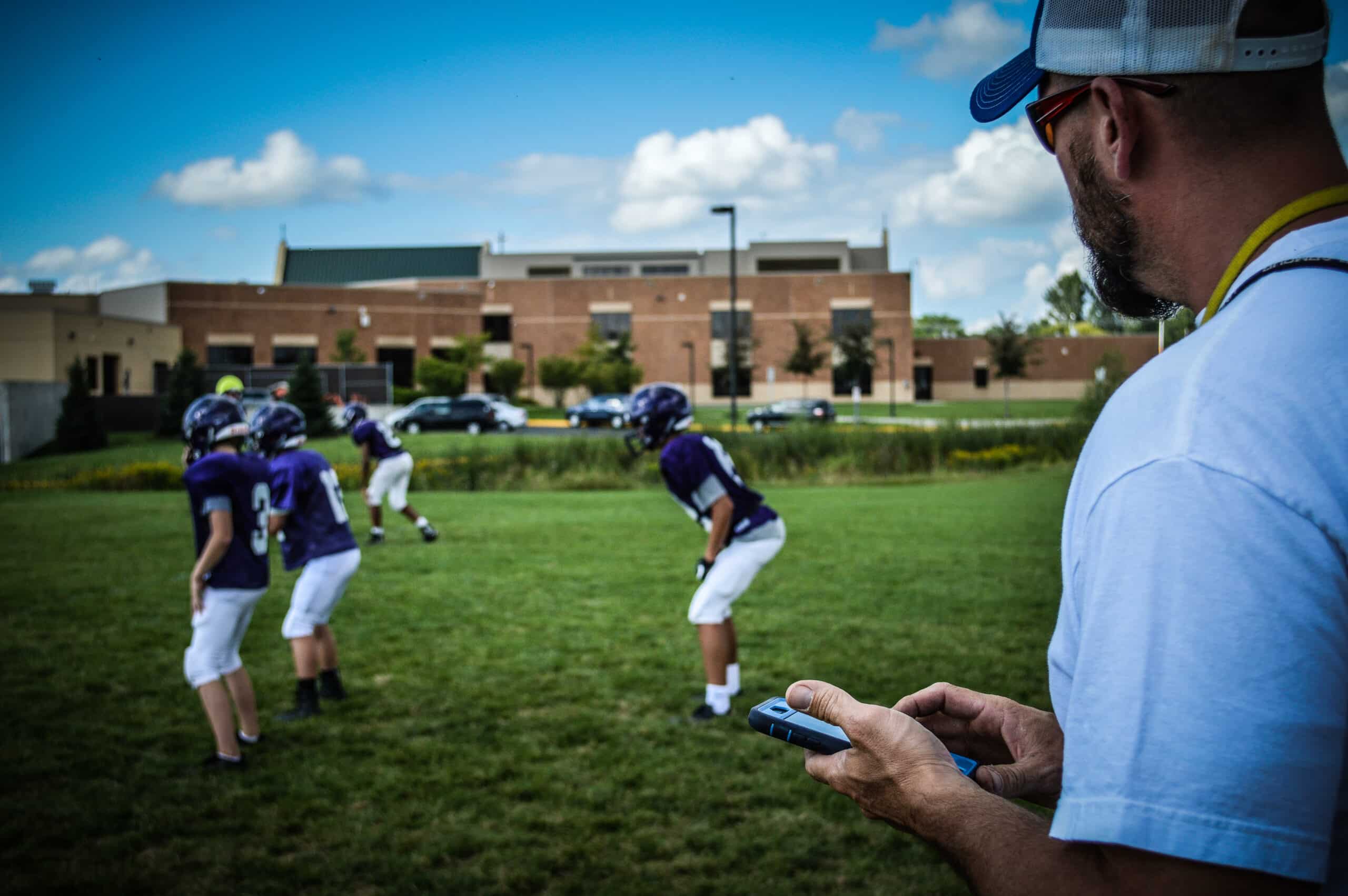
FAQs About Football Practice Plans
How do you structure a football practice?
You should structure your football practice in short, focused segments to cover the most material in your allotted practice time. It’s important to mix individual work with small group and full team activities.
A typical practice follows this template:
- Warm up and stretch
- Individual practice (Indy)
- Group periods
- Full team practice (Scout and situational)
- Special teams
- Conditioning
- Cool down
What are the 5 C’s of football?
The 5 C’s of football are:
- Commitment
- Communication
- Concentration
- Control, and
- Confidence
These five “C’s” help establish your team’s culture and mental strength. They are used by coaches to help develop mental and social skills.
What are 7 on 7 football drills?
7-on-7 football drills are periods of practice when seven offensive players go up against seven defensive players. This is designed to give players the opportunity to work in semi-live game situations without the full 11-on-11 units.
It’s typically used to practice running routes and throwing passes, removing both the offensive and defensive line (except for the center).
7-on-7 drills are separate from 7-on-7 football, which are leagues where teams compete in actual games with only seven players on each side of the ball. Flag football leagues often use the 7-on-7 format.
How long should a football practice be?
A typical gridiron football practice can range anywhere from 90 minutes to three hours. Your practice length varies depending on several factors including skill level, time of year, access to facilities, and more.
Youth leagues tend to run shorter practices due to limited time on the practice field and shorter attention spans. Advanced leagues run longer practices, especially early in the season. Other components outside of physical practice, like scout film sessions, add more time to your practice schedule.
What Should I Do To Prepare For Football Practice?
To prepare for football practice as a coach, you should meet with your staff to define goals and establish your team culture. Then, work as a staff to create defined time blocks to cover all of the material you need to in each practice.
Players prepare for practice differently. As a player, you need to come in with a strong mentality and treat practice with the same intensity you would a game. It’s important for players to stretch and warm up before practice to prevent injury, and drink enough water to stay hydrated throughout.
Get The Most Out Of Your Team With GoRout’s Football Practice Plan Templates
Efficient and Effective
Our football practice plan is designed to eliminate wasted time and ensure every session is structured for maximum impact. With organized periods covering fundamental drills, team strategy, and game-like scenarios, coaches can efficiently manage practice time while developing players at every position. This plan provides a clear roadmap to help teams build consistency, improve execution, and be fully prepared for game day.
Learn from the Best
We’ve taken your coaching to the next level by embedding YouTube links to elite-level drills inspired by top high school, college and professional programs. Whether it’s quarterback footwork, offensive line pass protection, or defensive tackling techniques, each drill is designed to enhance skill development. With comprehensive, progressive training, players at every level will improve their fundamentals and execution.
Prepare. Execute. Dominate.
Success on the field starts with preparation, and our football practice plan ensures your team is ready for any game situation. From scripted team periods to competitive drills that simulate real-game pressure, this plan helps coaches install plays, sharpen decision-making, and develop players' ability to execute under any circumstance. With a balance of individual skill work, group sessions, and full-team scenarios, your team will be mentally and physically prepared for game day.
